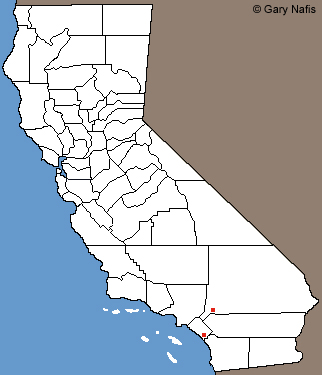|
This species has been introduced into California. It is not a native species.
|
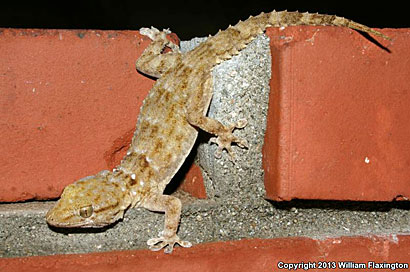 |
| Adult, Redlands, San Bernardino County © William Flaxington |
 |
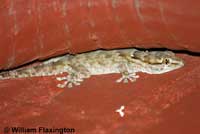 |
| Adult, San Juan Capistrano, Orange County |
Adult, Redlands, San Bernardino County
© William Flaxington |
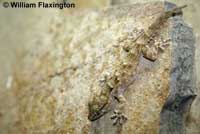 |
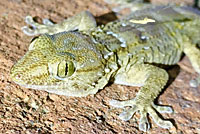 |
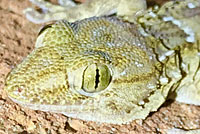 |
Adult, Redlands, San Bernardino County
© William Flaxington |
Adult, San Juan Capistrano, Orange County |
| |
|
|
| Habitat |
 |
 |
 |
| Habitat, Redlands, San Bernardino County |
| |
| Description |
| |
| Size |
Adults grow up to 7-8 inches total length (17.8 - 20.3 cm) with a maximum head-body size of 5.5 inches (14 cm).
(Powell, Conant, & Collins, 2016)
|
| Appearance |
A robust-bodied lizard with rows of large rough tubercular scales covering the back, raised scales covering the limbs and tail, elongated toes.
Numerous
transverse and circular bands of scales on the tail give this species the Latin name annularis and the common name ringed:
"This species is remarkable for its tail, which is enveloped in numerous transverse and circular bands, separated from each other by very pronounced furrows.... the caudal bands of the Ring Gecko are... formed of a multitude of small scales placed one above the other in more or less irregular lines. Hence the existence on each band of a crowd of secondary furrows, very little visible, especially on the upper face of the tail, and very different from the principal furrows, which formed by scaly folds of the skin, and surrounding the whole caudal extension, are generally seen with the greatest clarity."
(St-Hillaire, 1809) |
| Color and Pattern |
Color is gray or tan.
Usually with 4 distinctive white spots with dark borders on the shoulder that form semi ring-like markings.
These spots are often not present on juveniles.
Numerous transverse and circular bands of scales on the tail give this species its common name.
(See Meaning of the Scientific Name below.)
|
| Male/Female Differences |
| Males are larger than females, with a broader head. |
| Young |
The spots are sometimes not present or not easily visible on juveniles.
Hatchlings are about 2 inches long. (Bartlett & Bartlett) |
| Similar Non-native Geckos Found in California |
Moorish Geckos are smaller with more wrinkled skin with more prominent tubercles and they do not have white spots on the shoulders.
Mediterranean Geckos are smaller with fewer large tubercles and lack the white spots on the shoulders.
Peninsular Leaf-toed Geckos are smaller, with fewer tubercles and no white spots and in California are only found on rocks in the Colorado Desert in the extreme south-central part of the state. They are not found in urban or suburban areas.
|
| Behavior and Life History |
Nocturnal.
Pugnacious, biting readily when grabbed. |
| Sound |
| Makes an audible squeaking sound when threatened or disputing territory with others of the species. |
| Diet and Feeding |
| Prey includes invertebrates and small lizards. |
| Reproduction |
In northern Africa, females produce several sets of 2 eggs each season. (Bartlett & Bartlett)
|
| Habitat |
In California, found on urban buildings and in urban alleys.
|
| Geographical Range |
Native to parts of northern Africa.
Established in Florida, California and Arizona.
Apparently widespread in the Phoenix metropolitan area, possibly as the result of the intentional release of pets purchased by homeowners then released to control scorpions.
(Garcia, Sullivan, Bowker, Babb, Jones, Herpetological Review 51(4), 2020.)
Distribution in California
A population of T. annularis has been documented in Redlands, San Bernardino County.
In 2006 it was reported on the internet that there was a population of these geckos in Redlands. Comments in the H.E.R.P. database records indicate they have been present at least as early as 2002.
An unconfirmed rumor claims that the site of introduction was a pet store that was in the area but which no longer exists, that the store purchased a large group of the geckos in 1995, that an employee accidentally left their cage doors open and a number of geckos escaped into the store, and that despite store employees efforts to collect them all, they began breeding and about a year later had become established outside the store, which was confirmed when neighbors began bringing juveniles to the store to find out what they were.
William Flaxington went to the area and confirmed that the geckos were still there in 2007. Some of his photos can be seen above. Jonathan Hakkim confirmed that the geckos were still present in 2010 and 2012. You should be able to see pictures of geckos and the habitat taken by Will and Jonathan and other photographers on the H.E.R.P. database here.
In 2013 I gave Kent Beaman of the Natural History Museum of Los Angeles the locality information William Flaxington gave me for the geckos. Beaman had already searched for the geckos in Redlands but in a different area. With Flaxington's location information he was able to collect some specimens for the museum and publish the first documentation that the species was established in California in a Herpetologica Review Geographical Distribution note in September, 2014.
(Kent R. Beaman and David M. Goodward. Verified by Clark Mahrdt. Herpetological Review 45(3), 2014).
(The note did not mention William Flaxington's or Jonathan Hakkim's contributions.)
Another established population of non-native geckos preseumed to be T. annularis was discovered in San Juan Capistrano in Orange County in September, 2019. These geckos were confirmed to be T. annularis and documented in Hereptological Review in March, 2021.
(Samuel R. Fisher, Chelsea E. Martin, Robert N. Fisher. Herpetological Review 52(1), 2021.
The species Tarentola annularis - Ringed Wall Gecko, is listed on the 2008 SSAR Alien Species list as native to northern Africa and established in Florida in Lee and Miami-Dade counties - possibly established from a pet store release in Tallahassee.
|
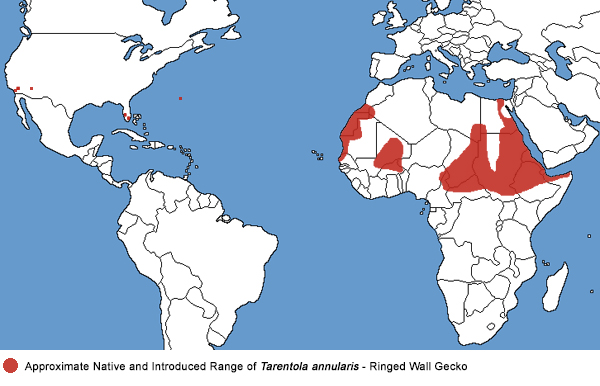
(Based on a map at iNaturalist.org)
|
| Taxonomic Notes |
Two subspecies are recognized:
Tarentola annularis annularis Geoffroy De St-Hilaire 1827
Tarentola annularis relicta Joger 1984
Alternate and Previous Names
White-spotted Wall Gecko
Gecko annularis - Le Gecko Annulaire - Ring Gecko - Geoffroy Saint-Hilaire, 1809 or 1827.
|
| Conservation Issues (Conservation Status) |
I have not seen any studies that describe a possible threat to native species from this invasive gecko, but native Western Fence Lizards and Southern Alligator Lizards could also occupy the same habitat and compete with it for resources, though they are diurnal lizards while this gecko is nocturnal.
|
|
|
Taxonomy |
| Family |
Gekkonidae |
Geckos |
Gray, 1825 |
| Genus |
Tarentola |
Wall Geckos |
Gray, 1825 |
Species
|
annularis |
Ringed Wall Gecko |
(Geoffroy Saint-Hilaire, 1827) |
|
Original Description |
Geoffroy De St-Hilaire 1827 (1809?)
|
|
Meaning of the Scientific Name
|
Tarentola = Italian for "tarantula" (Also, a diminutive of the place name Taranto, a city in Italy.)
The word "annularis" is derived from the Latin word "anulus" (ring) meaning "ring-shaped" or "of, or relating to, or forming a ring" referring to the scales ringing the tail, discussed above.
|
|
Related or Similar California Herps
|
Peninsular Leaf-toed Gecko - Phyllodactylus nocticolus
Non-native geckos in California
Rough-tailed Gecko - Cyrtopodion scabrum
Common House Gecko - Hemidactylus frenatus
Indo-Pacific Gecko - Hemidactylus garnotii
Tropical House Gecko - Hemidactylus mabouia
Flat-tailed House Gecko - Hemidactylus platyurus
Mediterranean Gecko - Hemidactylus turcicus
Yellow Fan-Fingered Gecko - Ptyodactylus hasselquistii
Ringed Wall Gecko - Tarentola annularis
Moorish Gecko - Tarentola mauritanica
|
|
More Information and References
|
The Reptile Database
--------------------------------------------------------------------------------------------------------------------------------------------------------------------
Robert Powell, Roger Conant, and Joseph T. Collins. Peterson Field Guide to Reptiles and Amphibians of Eastern and Central North America. Fourth Edition. Houghton Mifflin Harcourt, 2016.
--------------------------------------------------------------------------------------------------------------------------------------------------------------------
Bartlett, R. D. and Patricia Bartlett. A Field Guide to Florida Reptiles ad Amphibians. Gulf Publishing, 1999.
--------------------------------------------------------------------------------------------------------------------------------------------------------------------
The Ringed Gecko and the Lobed Gecko. Pages 130-132. Description of the Reptiles Found in Egypt; By Mr. Le Chevalier Geoffroy-Saint-Hilaire, of the Royal Institute of France.
(Le Gecko Annulaire Et Le Gecko Lobé. pp 130-132. Description des Reptiles Qui se Trouvent en Égypte; Par M. Le Chevalier Geoffroy-Saint-Hilaire, de L'Institut Royal de France.)
Description of Egypt, or Collection of Observations and Research Made in Egypt During the French Army Expedition.
Published by order of His Majesty Emperor Napoleon the Great. Natural History. Volume One. In Paris, from the Imperial Printing House. M. DCCC. IX.
(Description de L'Égypte, ou Recueil des Observations et des Recherches Qui Été Faites en Égypte Pendant L'expédition de L'armée Francaise. Publié par les ordres de sa majesté L'empereur Napoleon Le Grand. Histoire Naturelle. Tome Premier. A Paris, de Limprimerie Impéraile. M. DCCC. IX.)
|
|
|
The following conservation status listings for this animal are taken from the July 2025 State of California Special Animals List and the July 2025 Federally Listed Endangered and Threatened Animals of California list (unless indicated otherwise below.) Both lists are produced by multiple agencies every year, and sometimes more than once per year, so the conservation status listing information found below might not be from the most recent lists, but they don't change a great deal from year to year.. To make sure you are seeing the most recent listings, go to this California Department of Fish and Wildlife web page where you can search for and download both lists:
https://www.wildlife.ca.gov/Data/CNDDB/Plants-and-Animals.
A detailed explanation of the meaning of the status listing symbols can be found at the beginning of the two lists. For quick reference, I have included them on my Special Status Information page.
If no status is listed here, the animal is not included on either list. This most likely indicates that there are no serious conservation concerns for the animal. To find out more about an animal's status you can also go to the NatureServe and IUCN websites to check their rankings.
Check the current California Department of Fish and Wildlife sport fishing regulations to find out if this animal can be legally pursued and handled or collected with possession of a current fishing license. You can also look at the summary of the sport fishing regulations as they apply only to reptiles and amphibians that has been made for this website.
|
| Organization |
Status Listing |
Notes |
| NatureServe Global Ranking |
|
|
| NatureServe State Ranking |
|
|
| U.S. Endangered Species Act (ESA) |
None |
|
| California Endangered Species Act (CESA) |
None |
|
| California Department of Fish and Wildlife |
None |
|
| Bureau of Land Management |
None |
|
| USDA Forest Service |
None |
|
| IUCN |
|
|
|
|
